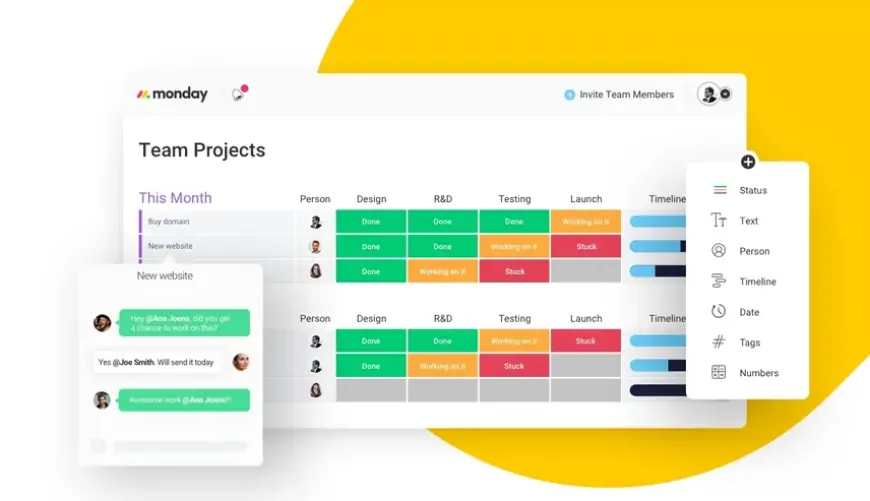Monday.com review 2024: Tips and tricks
"Monday.com is a versatile project management tool that streamlines workflows, boosts team collaboration, and enhances productivity with customizable features and integrations."

Our Verdict
Our Verdict
Monday.com is a cloud-based open platform enabling businesses to design their own work management tools and applications. Initially launched as a collaboration tool in 2014, it has evolved to support various workflows, including CRM, project management, software development, HR, and marketing. Users can choose from existing templates or create custom solutions tailored to their needs. Monday.com is ideal for small and midsized businesses (SMBs) due to its intuitive, visually appealing interface and user-friendly element names. Is this all-in-one platform the right fit for your SMB? Keep reading to discover more.
 Pros
Pros
- User-friendly interface
- Versatile applications
- Customizable workflows
 Cons
Cons
- Limited free features
- Overkill for simple needs

Automations
YesIntegration capabilities
YesCustomizable dashboards
YesMonday.com is a cloud-based work management platform designed to help businesses automate workflows and oversee projects, tasks, and resources all in one place. Its key strength is its versatility, making it suitable for various workflows, including project management, CRM, software development, and HR. Founded in 2012 with a mission to simplify team collaboration, monday.com has grown significantly, serving over 152,000 paying customers and going public on NASDAQ under the ticker symbol MNDY in 2021. The platform features a modern, spreadsheet-like interface that is intuitive and easy to navigate, even for new users.
Monday.com offers essential features like file storage, activity logs, embedded documents, and integrated mobile apps across all plans, whether free or paid. As your team grows and your requirements become more complex, you can upgrade to higher-tier plans that offer enhanced features for:
- Team collaboration
- Custom views and reporting
- Customer support
- Security and privacy
- Administration and control
- Reporting and analytics
What is Monday.com used for?
Monday.com is a highly adaptable platform suited for various workflows, including:
- Project management: Plan, track, and manage projects, set deadlines, assign tasks, monitor progress, and measure metrics.
- Customer Relationship Management (CRM): Track leads and customers, manage the sales pipeline, and close deals more effectively.
- Software development: Plan and track development sprints, manage backlogs, collaborate on code, and deploy applications.
- Human resources: Onboard new employees, manage records, track performance, and implement training programs.
Monday.com core features
Monday.com packs a wide array of features into one comprehensive tool. Here’s a look at some of its core features and their functions:
- Role assignment: Assign specific roles to team members to ensure they have access to the necessary features for their tasks. This helps track who is responsible for each assignment, promoting accountability and clarity.
- Timelines: Provides a clear, visual overview of project timelines, highlighting important dates, milestones, and deadlines. You can adjust timelines, add or remove tasks, and reorganize schedules to adapt to changing needs.
- Gantt Charts: Offers an intuitive Gantt chart view to visualize the entire project, including task dependencies, timelines, and ownership. This classic project management tool helps manage and track project progress.
- Software integrations: Supports a range of integrations with popular tools like Slack, Trello, Dropbox, and Google Drive. This enables you to incorporate existing tools into your workflow, enhancing productivity and streamlining processes.
- Dependencies: Allows you to set task dependencies, ensuring that tasks are completed in the correct sequence. This feature helps manage project flow and prevent delays by linking tasks in a logical order.
- Budgeting: Includes tools for tracking project expenses, monitoring resource usage, and setting budget limits. You can also configure alerts to notify you when expenses approach or exceed your budget, helping you manage finances effectively.
Monday.com ease of use
Monday.com features a drag-and-drop interface that simplifies task creation, management, and team member assignments. Its visual project management approach includes color-coded boards, charts, and various view formats, making it easy for team members to track project status and understand their roles.
Though some users might find certain features a bit complex, monday.com provides extensive resources such as documentation, webinars, and tutorials to help users quickly become proficient.
While the per-group seat pricing model may not be ideal for smaller businesses, and some users might desire more detailed control over project permissions, monday.com remains a user-friendly platform suitable for businesses of all sizes. However, businesses with simpler needs might find other platforms more straightforward.
Monday.com security
Monday.com upholds rigorous security standards, including adherence to multiple ISO protocols, HIPAA, SOC 1 Type II, SOC 2 Type II, SOC 3, the OWASP Top 10 framework, GDPR, and Cloud Security Alliance best practices. Data is encrypted with AES-256 (or stronger), and traffic is protected by at least TLS 1.2.
The platform employs various security measures, including firewalls, DDoS protection, rate limiting, NIDS sensors, advanced routing, and network traffic logging. Regular vulnerability assessments, end-to-end testing, unit testing, and static code analysis are conducted to maintain robust application security.














































